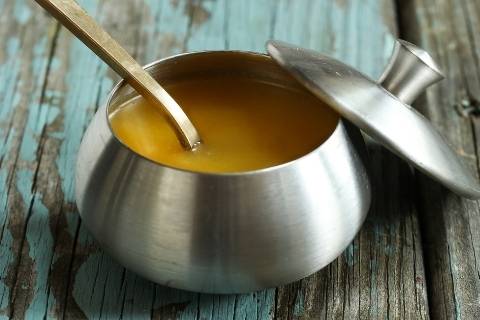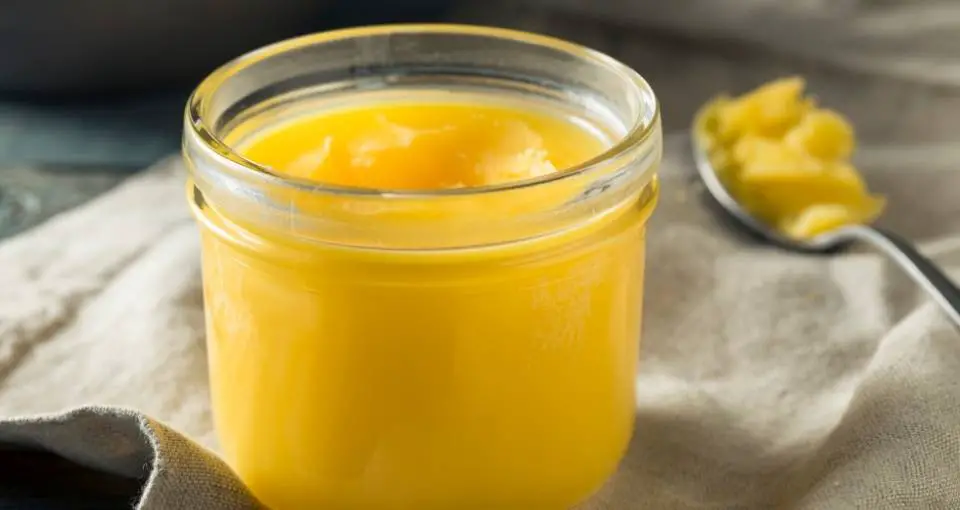Many people have misconceptions when it comes to storing ghee, but we will provide you with adequate information considering this matter. Ghee is purified butter that has evaporated, which leaves behind only pure butterfat. After extensive research, we have come out with the most straightforward conclusion for storing it.
Keep ghee in a dark and cool place, avoiding direct contact with light (This is because cow dairy is a photosensitive item).
However, there are many other considerations to take in mind when it comes to storing ghee. You have to take notice of the environment where you keep your ghee. Humidity, light, and heat exposure are factors you should consider if you want your ghee to last longer.
In this article, we will provide you with much-needed information following this matter, so you won’t have to think twice when you think about storing ghee.
Glass Jars like these mason jars on Amazon are perfect for storing ghee butter.
Which Container Is Best for Storing Ghee?
Depending on whether you’ve made your homemade ghee or bought it in a store, there are different ways to store it.
If you bought ghee in the store’s refrigerator section, it’s most likely you’ll want to keep it like that as well. The same goes the other way around. If you bought ghee from a shelf, consider storing it in the poultry.
If stored correctly, store-bought ghee can last even longer than the expiry date states, which is usually about one year. They typically come in sealed glass jars and opaque containers.
Making homemade ghee is not a difficult task, however preserving it rightly certainly is.
It would be best if you never stored your ghee in an open container, as it will ruin your hard work.
It’s important to notice that dipping your hand in a jar full of ghee can ruin it. The pH of your hand can harm the ghee, leading in it into being spoiled.
Cow ghee is best preserved in a well-tightened glass container. The glass should be dark and thin. However, always be careful with glass jars since they can be slippery.
This is also the most common way most people store their ghee.
If you want to be extra cautious, consider using virgin plastic made containers. It’s safer, considering plastic is unbreakable and can retain the ghee’s quality just as sound.
When handled with precaution, opened ghee can be used up to a year later.
Consider consuming your homemade ghee within three months of its creation. If you made a bit extra, there are always ways to preserve it, which we will cover later in the article.
Can We Store Ghee In Steel Containers?
Ghee, by its definition, is a type of clarified butter that has been evaporated in order to leave behind only the pure butterfat. Since ghee is almost entirely milkfat, this means that it can be stored just like oil. It’s not usual for ghee to go bad. However, it’s required to be stored properly.
A steel container is not recommended for storing ghee for a long time.
It’s fine if you plan on consuming the ghee in considerable time, but otherwise, there are other options.

In certain circumstances, it’s ok to keep ghee in an opaque container. However, people prefer keeping it in a darker airtight glass jar, especially if you plan on using it more often.
You maybe want to consider preserving ghee in an aluminum container only if you don’t plan on using it for a long time. Some people even keep ghee in a small casserole, since they don’t prefer deep glass jars.
The practice is to keep ghee in an airtight container, and then pour some in a casserole (as much as you plan to use soon).
Keep in mind, don’t allow your ghee to stay in it for too long, as the air will cause oxidation and eventually spoil your ghee.
Most ghee enthusiasts prefer glass jars since they provide them the security of keeping their ghee healthy.
Can Ghee Be Kept In The Fridge?
This question is something that has been bothering ghee lovers for a long time. Some think it’s fine storing ghee in the fridge, and some believe that keeping it in the pantry is just as good.
The consumption time of homemade ghee should usually be up to a year, and store-bought ghee, as long as it says on the expiry date. In case you didn’t open the jar until the expiry date, feel free to use it, as long as it looks and smells right.
The answer to the main question is straightforward.
If you plan to consume it for more than three months, it’s preferable to keep ghee in the fridge.
However, if you are using store-bought ghee and the manufacturer stated otherwise, always follow their instructions. Different qualities of ghee require specific treatment. You can even consider keeping unopened ghee at room temperature. As soon as you unseal it, you can transfer it to the refrigerator, to be extra safe.
It’s also beneficial to notice that after creating homemade ghee, it’s necessary to let it cool down for a while. Straight after it cooled down, transfer it into your desired container. Choose the container, depending on the way you plan to store your ghee.
If you want to take extra precautions, you can always store ghee in the fridge and take some quantity out for daily usage and store it on the shelf.
Also, storing ghee depends on how often you plan to use it. If you use it as a spreadable, it’s fine to keep it on a shelf(since you don’t have to wait for it to warm up), and if you use it for frying, keeping in the fridge is the way to go.
14 Great Ways To Use Milk Solids From Ghee
Can You Freeze Ghee?
Many ghee consumers like making their own homemade ghee. If they don’t do this often, they usually consider creating extra amounts for the future.
However, storing ghee in the fridge can keep it usable for about a year, which is not enough if you plan long-term.
Freezing is the best way of preserving ghee for an extended period.
Ghee can be kept in the freezer indefinitely. At least, that’s what most say. Either way, it will last longer than if you stored it in the fridge or on a shelf.
When planning to freeze ghee, you should consider some important matters if you want to preserve it correctly.
Not every glass jar is suitable for staying in the freezer for an extended period. Plastic freezer-safe containers are the way to go.
Using plastic containers will allow you to store ghee evenly in every container, organize, and, most importantly, label the storing date. Labeling is undoubtedly beneficial since you won’t have to think twice about when you’ve stored your ghee.
Some even keep their frosted ghee in plastic bags, which saves them some space. However, they lose the opportunity to organize their ghee correctly. Either way, separating the ghee is necessary because otherwise, they will freeze together.
When the time comes to defrost your ghee, you can move it to the fridge overnight, and in the morning, it should be ready to go. Of course, it’s recommended you first check the quality of your ghee.
Once defrosted, it should have the same quality it had before you frosted it. As you can see, freezing ghee is not complicated. Following the steps above, you shouldn’t have any problems in preserving your ghee.
How Do You Know If Ghee Has Gone Bad?
The lifespan of ghee certainly differs whether you bought it or made it yourself. If the ghee was created from organic cow fat, it’s prompted to have a longer lifespan from regular cow fat.
Either way, every ghee consumer should have some knowledge about alarming signs that may appear on your ghee when not stored correctly.
Ghee is much more resistant than regular butter. This is because of all of the milk fats that are removed in its creation. Avoid allowing moisture to contact your ghee, as it will spoil it even faster. And always touch it with a clean steel spoon.
Ghee can go bad when not stored correctly and when stored for too long. Rancid ghee has a specific sour flavor and distinct odor.
If you notice that your ghee doesn’t smell sweet (like milk), and doesn’t have a creamy yellow color, this means it’s bad, and you should not consume it.
However, some people tend to use rancid ghee and find ways of incorporating it. For example, if you notice your ghee has started to turn white, this is because of oxidation. And most likely, you forgot to tighten your lid. In this case, it’s fine to take off the white part and consume the rest, considering it’s ok.
This, of course, doesn’t apply if you notice something seriously wrong with your ghee, such as mold, discoloration, and sour taste. In this case, the risk isn’t worth it, and better throw it away.
Recommended Containers
I would recommend glass jars with sealed lids for storing ghee butter. You can find suitable mason jars on Amazon.


